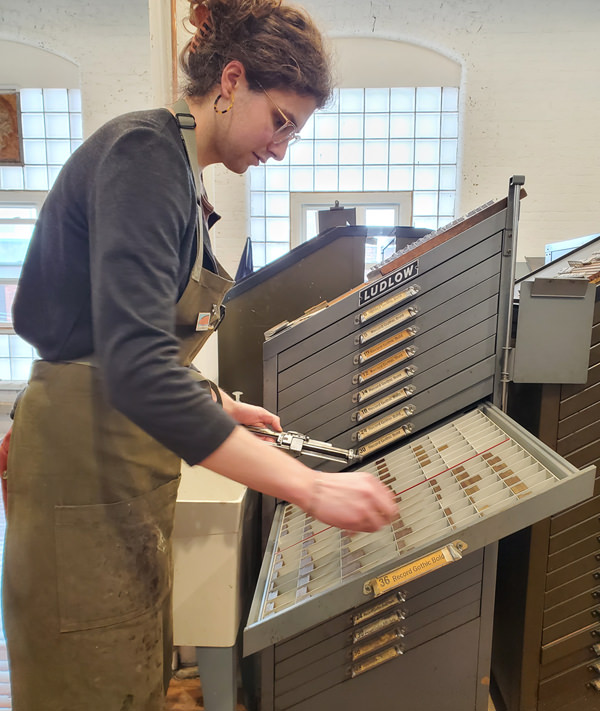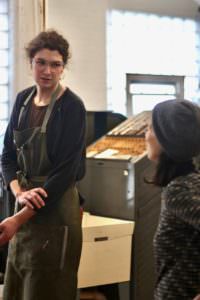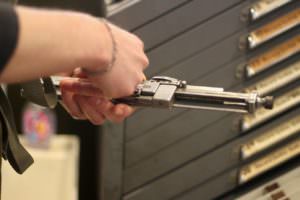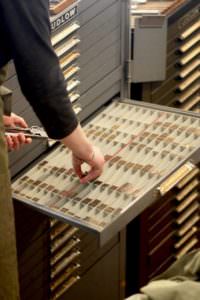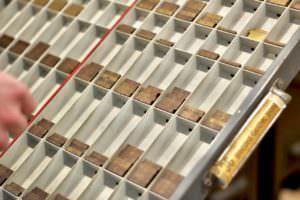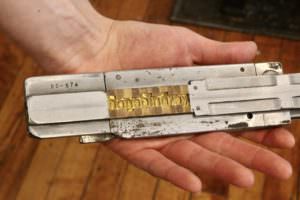 Hope Bindery was established in 1988 in Pawtucket, Rhode Island after owner Jim DiMarcantonio graduated from the Rhode Island School of Design with a BFA in Illustration.
Hope Bindery was established in 1988 in Pawtucket, Rhode Island after owner Jim DiMarcantonio graduated from the Rhode Island School of Design with a BFA in Illustration.
Traditional, hand binderies like Hope Bindery are the ultimate paper problem-solvers of often unique constructions that are in need of repair or a new “home”. In Jim’s words “no-nonsense solutions to binding problems while still exhibiting a sense of care and pride.”
Let’s meet Caleb Getto – they are the key staff and manager of Hope Bindery.
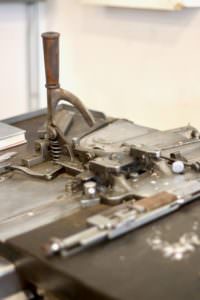 PC: Caleb, thanks for joining us. Talk about your background and how you came to Hope Bindery.
PC: Caleb, thanks for joining us. Talk about your background and how you came to Hope Bindery.
CG: I graduated from RISD with a BFA in printmaking. During the last three years at RISD, I was a work-study student at the RISD Museum Prints, Drawings, and Photographs Department as a matting and framing assistant for works on paper. I was fortunate to have the opportunity to continue working in this capacity part-time when I graduated. I also started working at Hope Bindery. Within a year, I committed myself to Hope Bindery full-time. While I loved the museum and colleagues, the Bindery offered an outlet to work with my hands that wasn’t limited to protecting existing artwork, but helping bring new work to life.
PC: What were your first impressions of Hope Bindery?
CG: Hope Bindery is such a special place, and that is very evident from the moment you step through the doors. At any given time there is a huge variety of projects moving through the studio, from huge Piranesi volumes to artists’ books and clamshell boxes for printmakers and photographers. Walk two doors down the hall and you’re in our typecasting studio. Three Ludlow typography machines line the left-hand wall and the rest of the room is brimming with type cases full of brass matrices. Simply put, when I first arrived, I felt like there were few limits to what was possible in the space in terms of bookbinding. But, I also saw the opportunity for growth and expansion in seemingly infinite directions.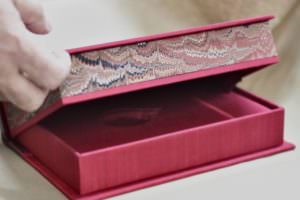
PC: What are the first steps when a new project comes into the Bindery?
CG: We have a principle at the Bindery; we try not to say no to any projects without exhausting all options we can think of for making our customer’s vision become a reality. Even if we don’t know exactly how we will do something, we can figure out a way. Projects always start with absorbing our customer’s ideas, once we understand what they are envisioning we can start figuring out logistics.
PC: When you start on a new personal creation – what’s your process?
CG: I don’t have a consistent way or method for making – as my work takes many different forms. The one thing I always come back to is writing. Writing is really what grounds my work and what helps me understand my visual expression. Most of my writing takes place on a typewriter. I find the physicality of words that come out of a typewriter very confrontational, more so than the handwritten word. When I write something on a typewriter I am forced to exist with these words in a much more interpersonal manner.
PC: What gives you satisfaction in your studio work and with Bindery projects/jobs?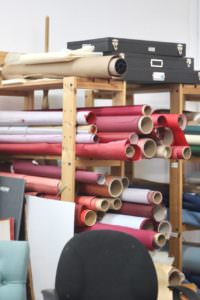
CG: In making my personal work, I gain satisfaction from being in the middle of something, whatever that may mean at a given time, and why I have different projects going at once. My favorite part of reading books – is being in the middle. There is a physical and contextual balance of what you know – and what is still to come.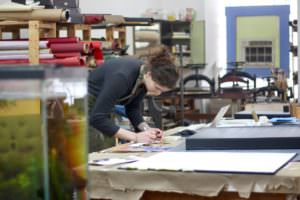
At the Bindery, we work on many small, often simple repairs that hold little monetary significance, but are charged with overwhelming sentimental value. Often these are books that have been passed down from loved ones or kept from childhood. I feel much more pressure with these books than with something that may be more expensive. While it is great making a set of beautiful clamshell boxes or an edition of artist books, getting to revive a piece that holds so much weight in people’s lives brings me much joy.
PC: Has the Bindery enhanced your portfolio of work and what has changed in you and your work since coming to the Bindery?
CG: Bookbinding and box-making have always been part of my practice, so, obviously, I have learned and refined skills in these technical areas. More than technical skills, however, the Bindery satisfies my craving for physical making. With this craving satiated, I have been able to slow down. Allowing time for projects to grow and evolve, through activity but also dormancy, without this overwhelming desire to consistently bring something into the world.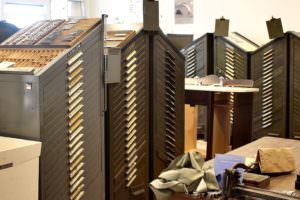
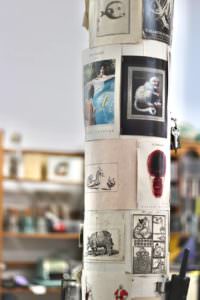
PC: Have you worked on an “eye-opening” binding job? Please tell us the story of a memorable client and/or client request.
CG: This was back when I worked at the Bindery and the RISD Museum. We were making a box set for Jess T. Dugan’s project – Every Breath We Drew. This was memorable for several reasons. First off, this was for an artist with a beautiful body of work I admired and one of the first box projects I felt fully involved in. The boxes turned out great. Weeks later, I walked into the (RISD) Museum’s storage area, to find the very same boxes filled with Jess’s photographs. While I could talk about projects that were particularly interesting technically, this was an instance of “right place, right time”. Seeing the impact of my work at the bindery so directly and immediately brought me so much joy and such a sense of satisfaction.
PC: Is there a specific area of interest within the capabilities of the Bindery?
CG: From a physical standpoint I enjoy the process of box-making most. There is something very satisfying about the collaboration that exists between a box and the prints, photographs, etc. that it holds. Boxes are protectors and collaborators in storytelling at their best. Book cover design is much the same. I love working with customers to translate the narrative or mood of their work into a cover design that compliments and reinforces the interior material.
PC: How do you imagine the future of Hope Bindery?
CG: I love the work that we already do, that’s why I grew to care for the bindery so much. But, as I said before, one of the things that I love about the place is that there are seemingly infinite ways in which it could expand, grow, and evolve. In the long run, the one idea that sticks in my mind is creating an artist book residency program. I love working with artists on book projects and it would be wonderful to be able to give artists the time and space to explore the book format. To make this into a reality it would be ideal to be able to expand with printmaking facilities for the artists to utilize. It would also mean expanding into publishing to some degree which is also something that is very intriguing.
PC: Name one or more influences in your life.
There are lots of influences in my life that I could speak about, but I think the most relevant is someone from my childhood named John Nichols. Along with many other things, he is the owner of a skate shop that expanded into a record store where I grew up in Massachusetts, Technical Skateshop & Inclusion Records. He taught me how to skateboard, and although that phase in my life didn’t last long, his impact on me seems to linger. He was one of the first people that was able to illustrate to me that I was not bound to certain conventions of being. I could be a unique person with however many different interests, no matter how disparate or conflicting they may seem. He was the first person in my life that was able to offer a means of dismantling the conventions and binaries that existed in my small town and for that, I am very grateful.
He is also one of the few prominent people in my life who have owned small businesses. When I first started at the Bindery, I found I had a strong desire to work in a small business that I didn’t know existed beforehand. I feel like the example of John must have played a role in that.
PC: Thank you, Caleb! We really appreciate you taking the time to think introspectively and write about your approach to your artwork and work at the Bindery. We look forward to taking some of your future local workshops and learning about binding and box making.

